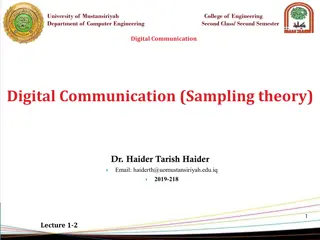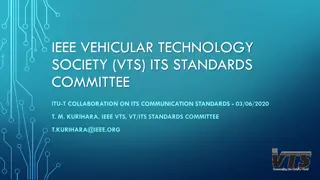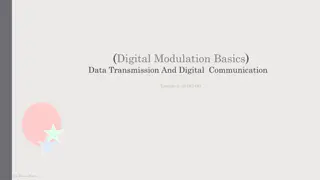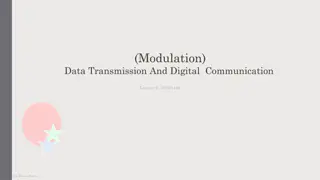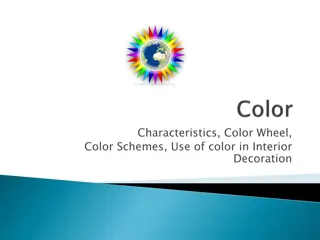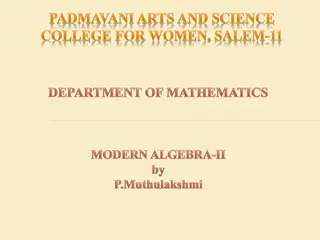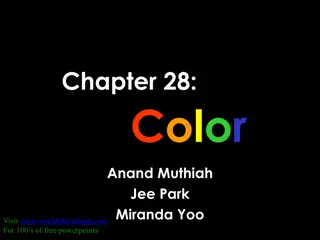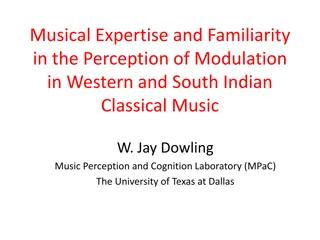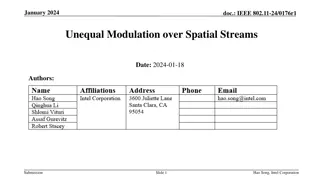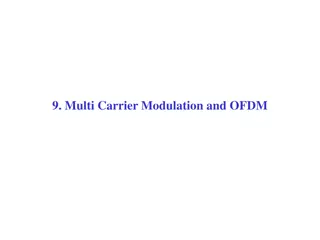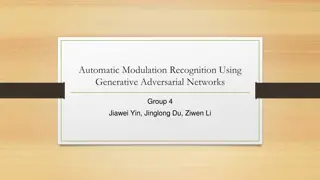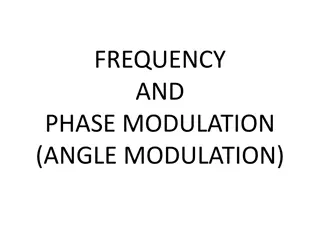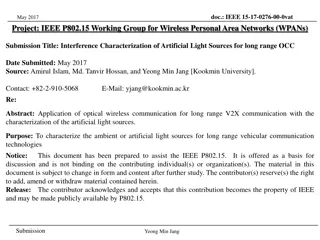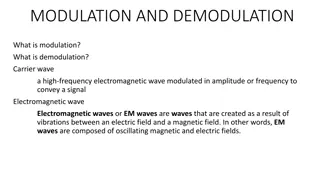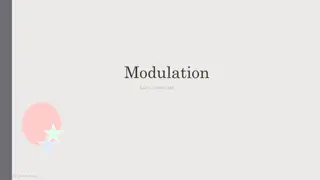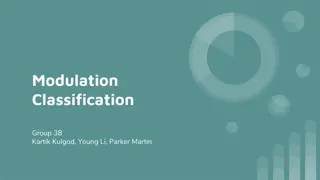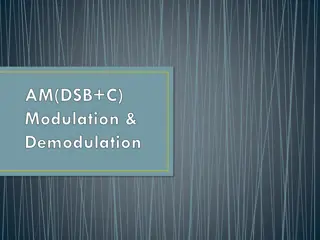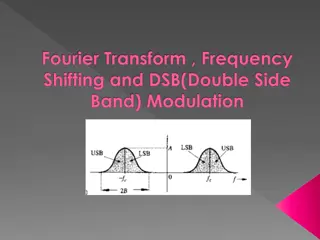
Color Spaces for Vehicular Light Communication
Explore the use of various color spaces for vehicular light communication modulation, addressing system requirements and technical considerations. The document delves into the need for brightness control, dependency on light source characteristics, data transmission stability, and adaptiveness to different data rates. It also discusses the concept of using multiple coordinates to represent colors in a multi-dimensional light space for optimal color modulation.
Download Presentation

Please find below an Image/Link to download the presentation.
The content on the website is provided AS IS for your information and personal use only. It may not be sold, licensed, or shared on other websites without obtaining consent from the author. If you encounter any issues during the download, it is possible that the publisher has removed the file from their server.
You are allowed to download the files provided on this website for personal or commercial use, subject to the condition that they are used lawfully. All files are the property of their respective owners.
The content on the website is provided AS IS for your information and personal use only. It may not be sold, licensed, or shared on other websites without obtaining consent from the author.
E N D
Presentation Transcript
doc.: IEEE 15-17-0402-00-0vat July 2017 Project: IEEE P802.15 Working Group for Wireless Personal Area Networks (WPANs) Submission Title:Various Color Spaces for Vehicular Light Communication Modulation Date Submitted: July 2017 Source: Soo-Young Chang (SYCA), Jaesang Cha (SNUST) Address: Contact Information: 530 574 2741 [sychang@ecs.csus.edu], +82-2-970-6431 [chajs@seoultech.ac.kr] Re: Abstract: Some system requirements/issues for vehicular OWC applications are identified in this document. Purpose: To suggest some technical requirements/issues for vehicular applications. Notice: This document has been prepared to assist the IEEE P802.15. It is offered as a basis for discussion and is not binding on the contributing individual(s) or organization(s). The material in this document is subject to change in form and content after further study. The contributor(s) reserve(s) the right to add, amend or withdraw material contained herein. Release: The contributor acknowledges and accepts that this contribution becomes the property of IEEE and may be made publicly available by P802.15. Submission Slide 1 Soo-Young Chang [SYCA]
doc.: IEEE15-17-0402-00-0vat July 2017 Various Color Spaces for Vehicular Light Communication Modulation Soo-Young Chang [SYCA] and Jaesang Cha [SNUST] Submission Slide 2 Soo-Young Chang [SYCA]
doc.: IEEE15-17-0402-00-0vat July 2017 CONSIDERATIONS FOR HIGH EFFICIENT MODULATION FOR LIGHT SIGNALS Need of brightness control or not Need superior brightness for optical wireless communications? It is more desirable for performance not to be affected by brightness control. Dependency of light source characteristics Is a modulation technique applied not dependent on technical characteristics of LEDs or other light sources deployed? Not (or negligibly) affected by background noise or not Offsetting the impact of background light sources Stable data transmission should be achieved even if the background noise is strong. Offers high robustness to background light Data speed Low to high data rates to be realized: adaptive to the amount of information delivered Adaptiveness to various data rates is important. Submission Slide 3 Soo-Young Chang [SYCA]
doc.: IEEE15-17-0402-00-0vat July 2017 BASIC CONCEPT: MULTIPLE COORDINATES TO REPRESENT COLORS A color can be generated by mixing lights from multiple light emitting devices such as LEDs. It is not necessary that light of a color can be generated by mixing lights from multiple light emitting devices with a unique set of intensities of lights. A multi dimensional space can be considered to represent colors. A multi dimensional light space can be used for color representation, but generally it is not true that there is only one point to represent each color: multiple points can be identified for a color. In the modulation scheme suggested in this contribution, two coordinates (x and y) for a two dimensional light space are considered. x and y are designed to be orthogonal to each other to be applied for the scheme: No correlation between these two. Any point in a space can be represented by a unique pair of these values. Similar to QAM Determine points which maximize the minimum distance among distances between any two points. Equi-distance strategy is a possible way to assign points. Submission Slide 4 Soo-Young Chang [SYCA]
doc.: IEEE15-17-0402-00-0vat July 2017 VARIOUS LIGHT SPACES Various light spaces available for color space modulation So far various light spaces have been suggested for representation of light colors. Colors of light signals can be represented by points in a light space. These light spaces can be defined in various ways. Typical examples: CIE1931, CIE1967, and CIE1976 spaces. Light sources and photo detection devices in a color space Any light source such as an LED can be represented with a point in a light space for its color. Any photo detector such as a photo diode can be represented with a point in a light space. Submission Slide 5 Soo-Young Chang [SYCA]
doc.: IEEE15-17-0402-00-0vat July 2017 VARIOUS LIGHT SPACES, CIE 1931 (1) Tristimulus values of a color the amounts of three primary colors in a three-component additive color model needed to match that target color: X, Y, and Z. Two light sources, appearing to be the same color made up of different mixtures of various wavelengths this effect is called metamerism. Two light sources have the same apparent color to an observer when they have the same tristimulus values, no matter what spectral distributions of light were used to produce them. Due to the nature of the distribution of cones in the eye, the tristimulus values depend on the observer's field of view. Submission Slide 6 Soo-Young Chang [SYCA]
doc.: IEEE15-17-0402-00-0vat July 2017 VARIOUS LIGHT SPACES, CIE 1931 (2) Color matching functions a set of three color-matching functions, called , , and For spectral power distribution, I( ), 325px-CIE1931_XYZCMF where is the wavelength of the equivalent monochromatic light (measured in nanometers). Other observers, such as for the CIERGB space or other RGB color spaces, are defined by other sets of three color-matching functions, and lead to tristimulus values in those other spaces. Submission Slide 7 Soo-Young Chang [SYCA]
doc.: IEEE15-17-0402-00-0vat July 2017 VARIOUS LIGHT SPACES, CIE 1931 (3) The CIE xy chromaticity diagram and the CIE xyY color space The outer curved boundary is the spectral (or monochromatic) locus, with wavelengths shown in nanometers. The concept of color can be divided into two parts: brightness and chromaticity. The Y parameter is a measure of the brightness or luminance of a color. 300px-CIExy1931 Submission Slide 8 Soo-Young Chang [SYCA]
doc.: IEEE15-17-0402-00-0vat July 2017 VARIOUS LIGHT SPACES, CIE 1976 (1) CIE 1976 is a strong candidate for CSM color space The CIE 1960, CIE 1964, and CIE 1976 color spaces were developed, with the goal of achieving perceptual uniformity to have an equal distance in the color space correspond to equal differences in color). Although they were a distinct improvement over the CIE 1931 system, they were not completely free of distortion. To utilize better perceptual uniformity, the CIE 1976 can be considered. And also it has less area that can not be covered by a triangle made with any three point colors. Submission Slide 9 Soo-Young Chang [SYCA]
doc.: IEEE15-17-0402-00-0vat July 2017 VARIOUS LIGHT SPACES, CIE 1976 (2) Perceptual uniformity of the CIE XYZ and CIE RGB color spaces The 1931 CIE chromaticity diagram is not perceptually uniform. The area of any region of the plot does not correlate at all well with the number of perceptually-distinguishable colors in that region. Other colour-space coordinate systems and plots exist; examples include CIE 1976 uv, also CIELUV, CIELAB... In general, by means of fairly abstract transforms these attempt to be more perceptually-uniform (with only limited success). Other more perceptually uniform spaces are more desirable. CIE1976 is a possibility. Which uniformity is more important, perceptual or detection: if perceptual uniformity is more important, more natural colors may be more easily realized; on the contrary, if detection uniformity is emphasized, lower BER may be achieved due to equal distances between two points. For both light emitting devices at transmitters and photo detectors at receivers, the same light space is applied. Therefore the same uniformity is applied with no distortion due to different light spaces. Submission Slide 10 Soo-Young Chang [SYCA]
doc.: IEEE15-17-0402-00-0vat July 2017 VARIOUS LIGHT SPACES, CIE 1976 (3) 1976 CIE u'v' (or CIE LUV) Chromaticity Diagram (1) The advantage of the 1976 diagram is that the distance between points is now approximately proportional to the perceived color difference, something definitely not true in the 1931 diagram. attempted perceptual uniformity additive mixtures of different colored lights will fall on a line in CIELUV's uniform chromaticity diagram with a condition that the mixtures are constant in lightness. Historical inertia has won out over technical superiority: the 1976 diagram is not used as much as the original 1931 diagram. Submission Slide 11 Soo-Young Chang [SYCA]
doc.: IEEE15-17-0402-00-0vat July 2017 VARIOUS LIGHT SPACES, CIE 1976 (4) 1976 CIE u'v' Chromaticity Diagram (2) For conversion from 1976 CIE to 1931 CIE xy coordinates: x = 9u' / (6u' - 16v' + 12) y = 4v' / (6u' - 16v' + 12) z = (-3u' - 20v' + 12) / (6u' - 16v' + 12) For conversion from 1960 CIE uv to 1976 coordinates: u' = u u' = 4x / (-2x + 12y + 3) u' = 4X / (X + 15Y +3Z) v' = 3v/2 v' = 9Y / (X + 15Y + 3Z) v' = 9y / (-2x + 12y + 3) w' = (-6x + 3y + 3) / (-2x + 12y + 3) Submission Slide 12 Soo-Young Chang [SYCA]
doc.: IEEE15-17-0402-00-0vat July 2017 SYSTEM DIAGRAM USING COLOR SPACE MODULATION Color independent Visual-MIMO tranceiving procedure Submission Slide 13 Soo-Young Chang [SYCA]
doc.: IEEE15-17-0402-00-0vat July 2017 KEY PART FOR COLOR SPACE MOD: MAPPING Data-to-modulation mapping (transmitter) b1 b2 c1 c2 mapper cn bm Modulation-to-data demapping (receiver) c 1 c 2 b 1 b 2 demapper b m c k Submission Slide 14 Soo-Young Chang [SYCA]
doc.: IEEE15-17-0402-00-0vat July 2017 COLOR SPACES UTILIZED FOR VEHICULAR COMMUNICATION MODULATION Light color spaces Light color spaces can be defined. A point in a color space represents a color of light. Linearity and uniformity work in the space for mixing multiple light signals to generate a light signal having a specific color. 300px-CIExy1931 1931 CIE xy Color space 1976 CIE u'v' Color space Submission Slide 15 Soo-Young Chang [SYCA]
doc.: IEEE15-17-0402-00-0vat July 2017 UTILIZATION OF CONSTELLATION ON A COLOR SPACE Point of target color Point of a light emitting device Max area of constellation Maximum area of constellation is determined by two factors: Point of a target color visible to human eyes: this point becomes the origin of constellation. Gamut formed by primary color points which represent points of light emitting devices used. Maximum constellation area determined rc Constellation area with radius rc Gamut formed by seven light emitting devices Submission Slide 16 Soo-Young Chang [SYCA]
doc.: IEEE15-17-0402-00-0vat July 2017 GENERATION OF CONSTELLATION y Normalized constellation Inside a unit circle centered at the original, 2mpoints are assigned so that the minimum distance between any two points be maximized. x Examples of constellation y y m=4 2m=16 points x x m=3 2m=8 points m=2 2m=4 points Submission Slide 17 Soo-Young Chang [SYCA]
doc.: IEEE15-17-0402-00-0vat July 2017 CONCLUSIONS Color space modulation scheme has some advantages over conventional schemes Independent of brightness control Not to be affected by brightness control. Dependency of light source (such as LEDs) characteristics Modulation technique applied is not directly dependent on technical characteristics of LEDs or other light sources deployed. Not (or negligibly) affected by background noise Adaptiveness to various data rates Simple implementation Fore this scheme, color spaces with better perceptual uniformity are more desirable So far, CIE 1976 is a strong candidate. This modulation scheme can be applied to vehicular light communication areas. Slide 18 Submission Soo-Young Chang [SYCA]

